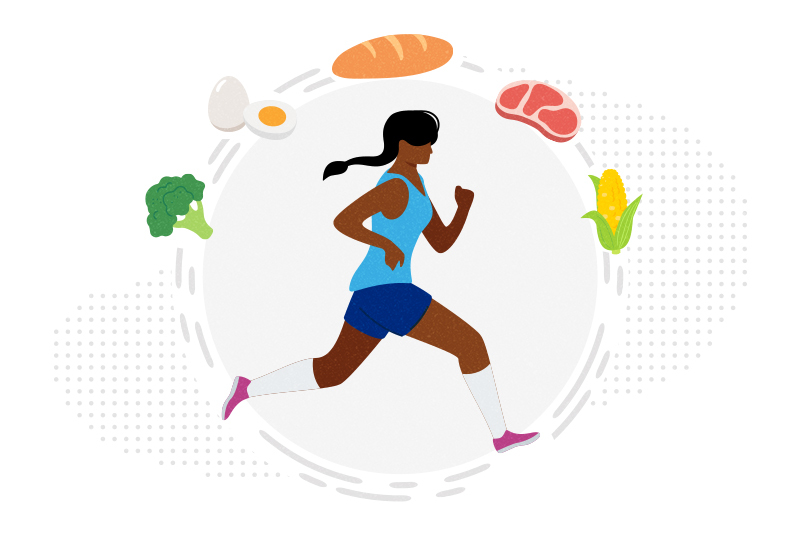The surprising energy demands of marathon training

Training for a marathon? Are you eating enough to help your body recover from one long training run and gear up for the next one?
A surprising number of marathon runners don’t. In a study of athletes training for the Boston Marathon, more than two in five women and almost one in five men regularly burned more energy than they replaced with food.
On race day, marathoners who hadn’t refueled sufficiently had slower times and required more medical assistance along the route than other competitors. Many of them had to withdraw from the event as a result.
In the world of sports nutrition, this sort of mismatch between energy intake and output has a name: low energy availability. It’s like trying to complete a 100-mile car trip with only enough gas for 70 miles.
How being low on fuel can make runners slower
When energy is in low supply, your body must pick and choose where to direct that energy, says clinical nutrition specialist Nicole Farnsworth. Some athletes feel tired throughout the day. Others become prone to stress fractures and other overuse injuries. Many see a drop in performance despite diligent training.
The Boston Marathon study
Researchers surveyed more than 1,000 athletes training for the 2022 Boston Marathon. Runners with signs of low energy availability had significantly slower times on race day than those of similar age, sex, BMI, and training. The study was led by Boston Children’s Injured Runners Clinic and Female Athlete Program.
The myth that “lighter is faster” — one that Farnsworth and her colleagues have spent years trying to dispel — compels some marathoners to take in less fuel than they need. “There’s still a lot of fear around food, body changes, and performance,” she says. “The important takeaway of this study is that fueled is faster,” she says.
But many runners simply don’t realize how much energy it takes to train for a marathon. Below, Farnsworth shares some of the unexpected reasons that low energy availability is so common among endurance athletes and why a nutrition plan is just as important as a training plan to set you up for marathon success.
Long runs can make you less hungry
As ironic as it seems, a long or challenging run can suppress your appetite. “This is commonly understood to be due to hormonal changes that occur following exercise,” says Farnsworth. The higher the intensity, the more tamped down your appetite may get.
Hungry or not, your body needs energy after a long run. And there’s an ideal window — 15 to 30 minutes post workout — when a mix of carbohydrates and protein can most effectively replenish your energy supply and boost your muscles’ recovery.
Plan your runs, plan your meals
Even after that first half hour, eating only when hungry almost certainly won’t keep your engine well fueled. Rather, Farnsworth says, when training for a marathon, nutrition needs to be structured around energy needs, not hunger cues. A nutrition plan can help.
Just as a training plan tells you when and how long to run, a nutrition plan tells you when and how much to eat. As the mileage and intensity of your workouts increase, so do the timing and amount of your meals and snacks.
BMI is overrated and misunderstood
In addition to low energy availability, the Boston Marathon study shines a light on body mass index (BMI) and the myths surrounding it.
Low BMI, the study found, does not equal superior athleticism. Rather, across all levels of competition, marathoners with enough fuel in their tanks ran faster on race day, no matter what their BMI.
“People think, ‘calories in, calories out,’” says Farnsworth. “But there’s a lot more complexity than that.” An athlete’s age, marathon experience, number of hours they train, and target finish time all play a role in their ideal nutritional intake. This is where a dietitian can help, by developing a nutrition plan that takes these factors — and more — into account.
Just as a training plan tells you when and how long to run, a nutrition plan tells you when and how much to eat.
It’s also one of the aspects Farnsworth loves about her work. “I get to work with athletes across the age and competitive spectrum to develop individualized plans that work for them.”
Whether you’re training for your first marathon or your fifth, whether you consider yourself young or old, fast or slow, whether you work with a sports nutritionist or not, remember this key message:
Fueled is faster.
Learn more about the Injured Runners Clinic and the Female Athlete Program.
Related Posts :
-

Fuel to be faster: Studying the effects of low energy availability at the Boston Marathon
Like many sports medicine specialists, Kristin Whitney, MD, MA, suspected that many of the issues she treats in runners — bone ...
-

Going for gold starts with breakfast: Nutrition advice for athletes
As they speed-climb 49-foot walls or spring across narrow balance beams, athletes rely on nutrition to provide the energy they ...
-

The key to preventing shin splints may be underfoot
Medial tibial stress syndrome, also known as shin splints, is a common and often recurring injury among adolescent runners. Recovery ...
-

Gait analysis gives runners a window into their form
Why can some runners compete in marathon after marathon while others get injured? The answer often lies in the runner’...





